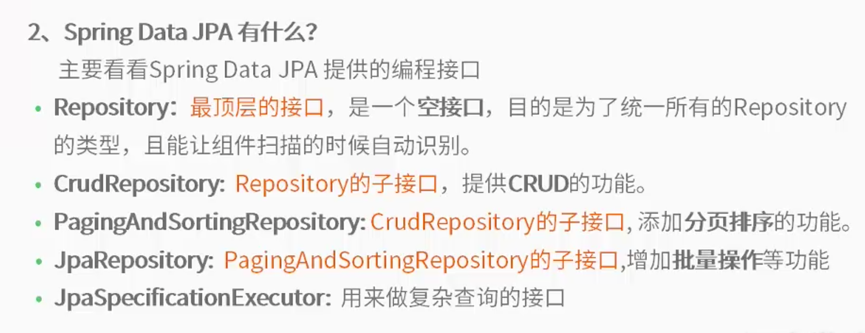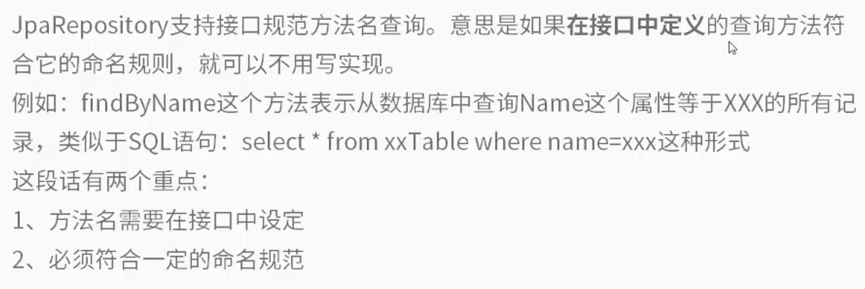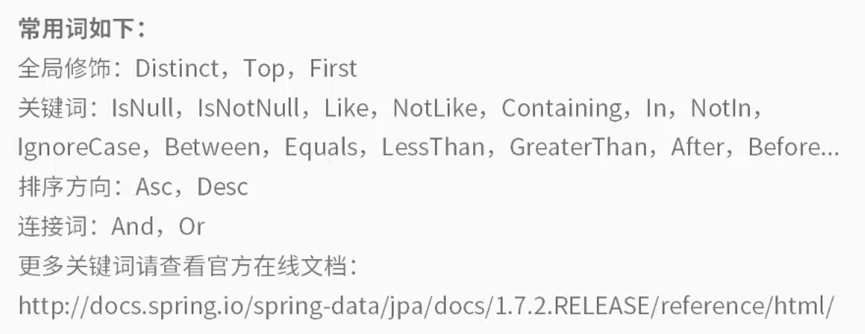Spring Data Repository的核心接口是Repository(好像也没什么好惊讶的)。这个接口需要领域类(Domain Class)跟领域类的ID类型作为参数。这个接口主要是让你能知道继承这个类的接口的类型。CrudRepository 供了对被管理的实体类的一些常用CRUD方法。
2. springboot 整合spring data jpa
默认你已经构建好了spring boot 项目,关于spring boot项目的新建,请参考:
springboot Demo
springboot 整合mybatis
2.1. 首先导入jar 包
springboot 整合spring data jpa 首先要导入依赖的jar包。pom.xml 文件中新增如下依赖:
<!-- spring-data-jpa -->
<dependency>
<groupId>org.springframework.data</groupId> <artifactId>spring-data-jpa</artifactId> </dependency> <dependency> <groupId>org.hibernate</groupId> <artifactId>hibernate-entitymanager</artifactId> </dependency> <dependency> <groupId>org.aspectj</groupId> <artifactId>aspectjweaver</artifactId> </dependency> <dependency>
<groupId>mysql</groupId>
<artifactId>mysql-connector-java</artifactId>
<version>5.1.21</version>
</dependency>
<!--data source spring data jpa 需要用c3p0 连接池--> <dependency> <groupId>com.mchange</groupId> <artifactId>c3p0</artifactId> <version>0.9.5.2</version> <exclusions> <exclusion> <groupId>commons-logging</groupId> <artifactId>commons-logging</artifactId> </exclusion> </exclusions> </dependency> - 1
- 2
- 3
- 4
- 5
- 6
- 7
- 8
- 9
- 10
- 11
- 12
- 13
- 14
- 15
- 16
- 17
- 18
- 19
- 20
- 21
- 22
- 23
- 24
- 25
- 26
- 27
- 28
- 1
- 2
- 3
- 4
- 5
- 6
- 7
- 8
- 9
- 10
- 11
- 12
- 13
- 14
- 15
- 16
- 17
- 18
- 19
- 20
- 21
- 22
- 23
- 24
- 25
- 26
- 27
- 28
2.2 配置datasource
新建DBConfig.Java 文件 配置数据源。
package com.example.config;
import java.beans.PropertyVetoException; import org.springframework.beans.factory.annotation.Autowired; import org.springframework.context.annotation.Bean; import org.springframework.context.annotation.Configuration; import org.springframework.core.env.Environment; import com.mchange.v2.c3p0.ComboPooledDataSource; @Configuration public class DBConfig { @Autowired private Environment env; @Bean(name="dataSource") public ComboPooledDataSource dataSource() throws PropertyVetoException { ComboPooledDataSource dataSource = new ComboPooledDataSource(); dataSource.setDriverClass(env.getProperty("ms.db.driverClassName")); dataSource.setJdbcUrl(env.getProperty("ms.db.url")); dataSource.setUser(env.getProperty("ms.db.username")); dataSource.setPassword(env.getProperty("ms.db.password")); dataSource.setMaxPoolSize(20); dataSource.setMinPoolSize(5); dataSource.setInitialPoolSize(10); dataSource.setMaxIdleTime(300); dataSource.setAcquireIncrement(5); dataSource.setIdleConnectionTestPeriod(60); return dataSource; } } - 1
- 2
- 3
- 4
- 5
- 6
- 7
- 8
- 9
- 10
- 11
- 12
- 13
- 14
- 15
- 16
- 17
- 18
- 19
- 20
- 21
- 22
- 23
- 24
- 25
- 26
- 27
- 28
- 29
- 30
- 31
- 32
- 33
- 34
- 35
- 1
- 2
- 3
- 4
- 5
- 6
- 7
- 8
- 9
- 10
- 11
- 12
- 13
- 14
- 15
- 16
- 17
- 18
- 19
- 20
- 21
- 22
- 23
- 24
- 25
- 26
- 27
- 28
- 29
- 30
- 31
- 32
- 33
- 34
- 35
2.3. 添加数据库连接信息
在配置文件application.properties中添加数据库连接信息如下:
ms.db.driverClassName=com.mysql.jdbc.Driver ms.db.url=jdbc:mysql://localhost:3306/msm?prepStmtCacheSize=517&cachePrepStmts=true&autoReconnect=true&characterEncoding=utf-8&allowMultiQueries=true ms.db.username=root ms.db.password=admin ms.db.maxActive=500- 1
- 2
- 3
- 4
- 5
- 1
- 2
- 3
- 4
- 5
2.4 配置JpaConfig
新建JpaConfig.java 文件内容如下:
package com.example.config;
import java.util.HashMap; import java.util.Map; import javax.persistence.EntityManagerFactory; import javax.sql.DataSource; import org.springframework.beans.factory.annotation.Autowired; import org.springframework.context.annotation.Bean; import org.springframework.context.annotation.Configuration; import org.springframework.data.jpa.repository.config.EnableJpaRepositories; import org.springframework.orm.jpa.JpaTransactionManager; import org.springframework.orm.jpa.LocalContainerEntityManagerFactoryBean; import org.springframework.orm.jpa.vendor.HibernateJpaVendorAdapter; import org.springframework.transaction.PlatformTransactionManager; import org.springframework.transaction.annotation.EnableTransactionManagement; @Configuration //此处是你dao文件所在的包名 @EnableJpaRepositories("com.example.*.dao") @EnableTransactionManagement public class JpaConfig { @Autowired private DataSource dataSource; @Bean public EntityManagerFactory entityManagerFactory() { HibernateJpaVendorAdapter vendorAdapter = new HibernateJpaVendorAdapter(); LocalContainerEntityManagerFactoryBean factory = new LocalContainerEntityManagerFactoryBean(); factory.setJpaVendorAdapter(vendorAdapter); //此处com.example.*.model是你的java bean所在的包名 factory.setPackagesToScan("com.example.*.model"); factory.setDataSource(dataSource); Map<String, Object> jpaProperties = new HashMap<String, Object>(); jpaProperties.put("hibernate.ejb.naming_strategy","org.hibernate.cfg.ImprovedNamingStrategy"); jpaProperties.put("hibernate.jdbc.batch_size",50); factory.setJpaPropertyMap(jpaProperties); factory.afterPropertiesSet(); return factory.getObject(); } @Bean public PlatformTransactionManager transactionManager() { JpaTransactionManager txManager = new JpaTransactionManager(); txManager.setEntityManagerFactory(entityManagerFactory()); return txManager; } } - 1
- 2
- 3
- 4
- 5
- 6
- 7
- 8
- 9
- 10
- 11
- 12
- 13
- 14
- 15
- 16
- 17
- 18
- 19
- 20
- 21
- 22
- 23
- 24
- 25
- 26
- 27
- 28
- 29
- 30
- 31
- 32
- 33
- 34
- 35
- 36
- 37
- 38
- 39
- 40
- 41
- 42
- 43
- 44
- 45
- 46
- 47
- 48
- 49
- 50
- 51
- 52
- 53
- 54
- 55
- 1
- 2
- 3
- 4
- 5
- 6
- 7
- 8
- 9
- 10
- 11
- 12
- 13
- 14
- 15
- 16
- 17
- 18
- 19
- 20
- 21
- 22
- 23
- 24
- 25
- 26
- 27
- 28
- 29
- 30
- 31
- 32
- 33
- 34
- 35
- 36
- 37
- 38
- 39
- 40
- 41
- 42
- 43
- 44
- 45
- 46
- 47
- 48
- 49
- 50
- 51
- 52
- 53
- 54
- 55
2.5 新建对应数据库表的实体类。(也就是java bean )
注意
@Entity
@Table(name = "sec_user")
标签的使用,@Entity表示这个是一个实体类,@Table(name = "sec_user") 中sec_user 是数据库中对应的表名
@Id
@GeneratedValue 对应ID
@Column(name = "name") 对应数据库中该列对应的列名,也就是属性名
package com.example.base.model;
import java.util.Date;
import javax.persistence.Column;
import javax.persistence.Entity;
import javax.persistence.GeneratedValue; import javax.persistence.Id; import javax.persistence.Table; import com.fasterxml.jackson.annotation.JsonIgnore; @Entity @Table(name = "sec_user") public class User { @Id @GeneratedValue(strategy=GenerationType.IDENTITY) private Integer id; @Column(name = "name") private String name; @Column(name = "password") private String password; @Column(name = "username") private String username; @Column(name = "division_id") private Integer divisionId; @Column(name = "email") private String email; @Column(name = "gender") private String gender; @Column(name = "mobilephone") private String mobilephone; @Column(name = "telephone") private String telephone; @Column(name = "user_type") private Integer userType; @Column(name = "create_by") private String createBy; @Column(name = "create_time") private Date createTime; @Column(name = "update_by") private String updateBy; @Column(name = "update_time") private Date updateTime; @Column(name = "disabled") private Integer disabled; @Column(name = "theme") private String theme; @Column(name = "is_ldap") private Integer isLdap; public String getName() { return name; } public void setName(String name) { this.name = name; } @JsonIgnore public String getPassword() { return password; } public void setPassword(String password) { this.password = password; } public String getUsername() { return username; } public void setUsername(String username) { this.username = username; } public Integer getDivisionId() { return divisionId; } public void setDivisionId(Integer divisionId) { this.divisionId = divisionId; } public String getEmail() { return email; } public void setEmail(String email) { this.email = email; } public String getGender() { return gender; } public void setGender(String gender) { this.gender = gender; } public String getMobilephone() { return mobilephone; } public void setMobilephone(String mobilephone) { this.mobilephone = mobilephone; } public String getTelephone() { return telephone; } public void setTelephone(String telephone) { this.telephone = telephone; } public Integer getUserType() { return userType; } public void setUserType(Integer userType) { this.userType = userType; } public String getCreateBy() { return createBy; } public void setCreateBy(String createBy) { this.createBy = createBy; } public Date getCreateTime() { return createTime; } public void setCreateTime(Date createTime) { this.createTime = createTime; } public String getUpdateBy() { return updateBy; } public void setUpdateBy(String updateBy) { this.updateBy = updateBy; } public Date getUpdateTime() { return updateTime; } public void setUpdateTime(Date updateTime) { this.updateTime = updateTime; } public Integer getDisabled() { return disabled; } public void setDisabled(Integer disabled) { this.disabled = disabled; } public String getTheme() { return theme; } public void setTheme(String theme) { this.theme = theme; } public Integer getIsLdap() { return isLdap; } public void setIsLdap(Integer isLdap) { this.isLdap = isLdap; } public Integer getId() { return id; } public void setId(Integer id) { this.id = id; } }- 1
- 2
- 3
- 4
- 5
- 6
- 7
- 8
- 9
- 10
- 11
- 12
- 13
- 14
- 15
- 16
- 17
- 18
- 19
- 20
- 21
- 22
- 23
- 24
- 25
- 26
- 27
- 28
- 29
- 30
- 31
- 32
- 33
- 34
- 35
- 36
- 37
- 38
- 39
- 40
- 41
- 42
- 43
- 44
- 45
- 46
- 47
- 48
- 49
- 50
- 51
- 52
- 53
- 54
- 55
- 56
- 57
- 58
- 59
- 60
- 61
- 62
- 63
- 64
- 65
- 66
- 67
- 68
- 69
- 70
- 71
- 72
- 73
- 74
- 75
- 76
- 77
- 78
- 79
- 80
- 81
- 82
- 83
- 84
- 85
- 86
- 87
- 88
- 89
- 90
- 91
- 92
- 93
- 94
- 95
- 96
- 97
- 98
- 99
- 100
- 101
- 102
- 103
- 104
- 105
- 106
- 107
- 108
- 109
- 110
- 111
- 112
- 113
- 114
- 115
- 116
- 117
- 118
- 119
- 120
- 121
- 122
- 123
- 124
- 125
- 126
- 127
- 128
- 129
- 130
- 131
- 132
- 133
- 134
- 135
- 136
- 137
- 138
- 139
- 140
- 141
- 142
- 143
- 144
- 145
- 146
- 147
- 148
- 149
- 150
- 151
- 152
- 153
- 154
- 155
- 156
- 157
- 158
- 159
- 160
- 161
- 162
- 163
- 164
- 165
- 166
- 167
- 168
- 169
- 170
- 171
- 172
- 173
- 174
- 175
- 176
- 177
- 178
- 179
- 180
- 181
- 182
- 183
- 184
- 185
- 186
- 187
- 188
- 1
- 2
- 3
- 4
- 5
- 6
- 7
- 8
- 9
- 10
- 11
- 12
- 13
- 14
- 15
- 16
- 17
- 18
- 19
- 20
- 21
- 22
- 23
- 24
- 25
- 26
- 27
- 28
- 29
- 30
- 31
- 32
- 33
- 34
- 35
- 36
- 37
- 38
- 39
- 40
- 41
- 42
- 43
- 44
- 45
- 46
- 47
- 48
- 49
- 50
- 51
- 52
- 53
- 54
- 55
- 56
- 57
- 58
- 59
- 60
- 61
- 62
- 63
- 64
- 65
- 66
- 67
- 68
- 69
- 70
- 71
- 72
- 73
- 74
- 75
- 76
- 77
- 78
- 79
- 80
- 81
- 82
- 83
- 84
- 85
- 86
- 87
- 88
- 89
- 90
- 91
- 92
- 93
- 94
- 95
- 96
- 97
- 98
- 99
- 100
- 101
- 102
- 103
- 104
- 105
- 106
- 107
- 108
- 109
- 110
- 111
- 112
- 113
- 114
- 115
- 116
- 117
- 118
- 119
- 120
- 121
- 122
- 123
- 124
- 125
- 126
- 127
- 128
- 129
- 130
- 131
- 132
- 133
- 134
- 135
- 136
- 137
- 138
- 139
- 140
- 141
- 142
- 143
- 144
- 145
- 146
- 147
- 148
- 149
- 150
- 151
- 152
- 153
- 154
- 155
- 156
- 157
- 158
- 159
- 160
- 161
- 162
- 163
- 164
- 165
- 166
- 167
- 168
- 169
- 170
- 171
- 172
- 173
- 174
- 175
- 176
- 177
- 178
- 179
- 180
- 181
- 182
- 183
- 184
- 185
- 186
- 187
- 188
2.5 编写spring data jpa 的dao层(重头戏哦)
首先我们先了解一下 spring data jpa 的命名规范,然后再开始编写一个简单的测试例子。
例子:
新建UserJpaDao类继承 JpaRepository
package com.example.base.dao;
import org.springframework.data.jpa.repository.JpaRepository;
import org.springframework.data.jpa.repository.Query;
import org.springframework.data.repository.query.Param;
import com.example.base.model.User; /** * The Interface UserJpaDao. * @author abel */ public interface UserJpaDao extends JpaRepository<User, Long> { /** * Find by name. * * @param name the name * @return the user */ User findByName(String name); /** * Find by name and user name. * 如果参数名为多个字母组成,请首字母大写。勿使用驼峰命名,jpa不识别驼峰 * @param name the name * @param age the age * @return the user */ User findByNameAndAge(String name, Integer age); /** * Find user. * User为@Entity 的名字 * @param name the name * @return the user */ @Query("from User u where u.name=:name") User findUser(@Param("name") String name); } - 1
- 2
- 3
- 4
- 5
- 6
- 7
- 8
- 9
- 10
- 11
- 12
- 13
- 14
- 15
- 16
- 17
- 18
- 19
- 20
- 21
- 22
- 23
- 24
- 25
- 26
- 27
- 28
- 29
- 30
- 31
- 32
- 33
- 34
- 35
- 36
- 37
- 38
- 39
- 40
- 41
- 1
- 2
- 3
- 4
- 5
- 6
- 7
- 8
- 9
- 10
- 11
- 12
- 13
- 14
- 15
- 16
- 17
- 18
- 19
- 20
- 21
- 22
- 23
- 24
- 25
- 26
- 27
- 28
- 29
- 30
- 31
- 32
- 33
- 34
- 35
- 36
- 37
- 38
- 39
- 40
- 41
2.6 service 层的编写(这一步和Spring mvc 已经没有什么差别的了。)
service 代码如下。(此处我就仅仅写了dao的一个方法)
package com.example.base.service;
import com.example.base.model.User;
/**
* The Interface UserService.
*/
public interface UserService { /** * Gets the user by name. * * @param username the user name * @return the user by name */ public User getUserByName(String username); } - 1
- 2
- 3
- 4
- 5
- 6
- 7
- 8
- 9
- 10
- 11
- 12
- 13
- 14
- 15
- 16
- 17
- 1
- 2
- 3
- 4
- 5
- 6
- 7
- 8
- 9
- 10
- 11
- 12
- 13
- 14
- 15
- 16
- 17
实现如下:
package com.example.base.service.Impl;
import org.springframework.beans.factory.annotation.Autowired;
import org.springframework.stereotype.Service;
import com.example.base.dao.UserJpaDao;
import com.example.base.model.User; import com.example.base.service.UserService; /** * * @ClassName UserServiceImpl * @author abel * @date 2016年11月10日 */ @Service public class UserServiceImpl implements UserService { @Autowired private UserJpaDao userJpaDao; /** * * @param UserName * @return */ @Override public User getUserByName(String username) { return userJpaDao.findByName(username); } } - 1
- 2
- 3
- 4
- 5
- 6
- 7
- 8
- 9
- 10
- 11
- 12
- 13
- 14
- 15
- 16
- 17
- 18
- 19
- 20
- 21
- 22
- 23
- 24
- 25
- 26
- 27
- 28
- 29
- 1
- 2
- 3
- 4
- 5
- 6
- 7
- 8
- 9
- 10
- 11
- 12
- 13
- 14
- 15
- 16
- 17
- 18
- 19
- 20
- 21
- 22
- 23
- 24
- 25
- 26
- 27
- 28
- 29
2.7 controller 编写
package com.example.base.controller; import javax.servlet.http.HttpServletRequest; import java.util.Map; import org.springframework.beans.factory.annotation.Autowired; import org.springframework.http.HttpStatus; import org.springframework.http.ResponseEntity; import org.springframework.stereotype.Controller; import org.springframework.web.bind.annotation.RequestMapping; import org.springframework.web.bind.annotation.RequestMethod; import org.springframework.web.bind.annotation.ResponseBody; import com.example.base.service.UserService; import com.example.base.util.CommonUtil; /** * * @ClassName UserController * @author abel * @date 2016年11月10日 */ @Controller @RequestMapping(value = "/users") public class UserController { @Autowired private UserService userService; /** * 通过spring data jpa 调用方法 api :localhost:8099/users/byname?username=xxx * * @param request * @return */ @RequestMapping(value = "/byname", method = RequestMethod.GET) @ResponseBody public ResponseEntity<Object> getUser(HttpServletRequest request) { Map<String, Object> map = CommonUtil.getParameterMap(request); String username = (String) map.get("username"); return new ResponseEntity<>(userService.getUserByName(username), HttpStatus.OK); } }


























 460
460











 被折叠的 条评论
为什么被折叠?
被折叠的 条评论
为什么被折叠?








